Invasive and Incomplete
How flood cleanup left eastern Kentucky feeling violated and vulnerable
by Jared Bennett and Justin Hicks
for The Kentucky Center for Investigative Reporting
-- Hover on highlighted areas to see documents. --
Story published April 26, 2023 || Radio special published Sept. 8, 2023
On a steamy day in August, Don Young dug through the rubble that used to be his home. He was desperately trying to salvage the most precious possessions representing the life he’d made in McRoberts, Kentucky.
Floods last July ravaged Young’s community and much of eastern Kentucky. But the wreckage that surrounded him that day was not caused by the storm.
Instead, it was caused by companies hired to pick up debris in the months after the flood.
Without any notice, cleanup crews ripped apart the home that Young shared with his wife, Malissa, for nearly 30 years. The mobile home had been lifted off the foundation, but was still intact.
For weeks the Youngs had been working to pack up what they could from the inside: Baby photos, home videos, memorabilia from Don’s time spent as a state police officer.
“Stuff like that, you can't replace it,” he said. “You wouldn't have took millions for it. And they just came and destroyed it like it was nothing.”
Malissa Young, a Letcher County public school teacher, grew up on this plot of land. Looking over the dirt lot where her home once stood, she said she’ll never move back.
“It’s like a death. You go through it once with the house and it being flooded,” she said before trailing off.
“...and then they come in and tear down everything that you did save and haul it off,” Don said, finishing her thought.
A Kentucky Transportation Cabinet official overseeing the cleanup process called Don personally and afterwards told him to file a negligence claim with the state Board of Claims. They filed a claim seeking $400,000 to pay for the house and their belongings.
Instead, the state formally denied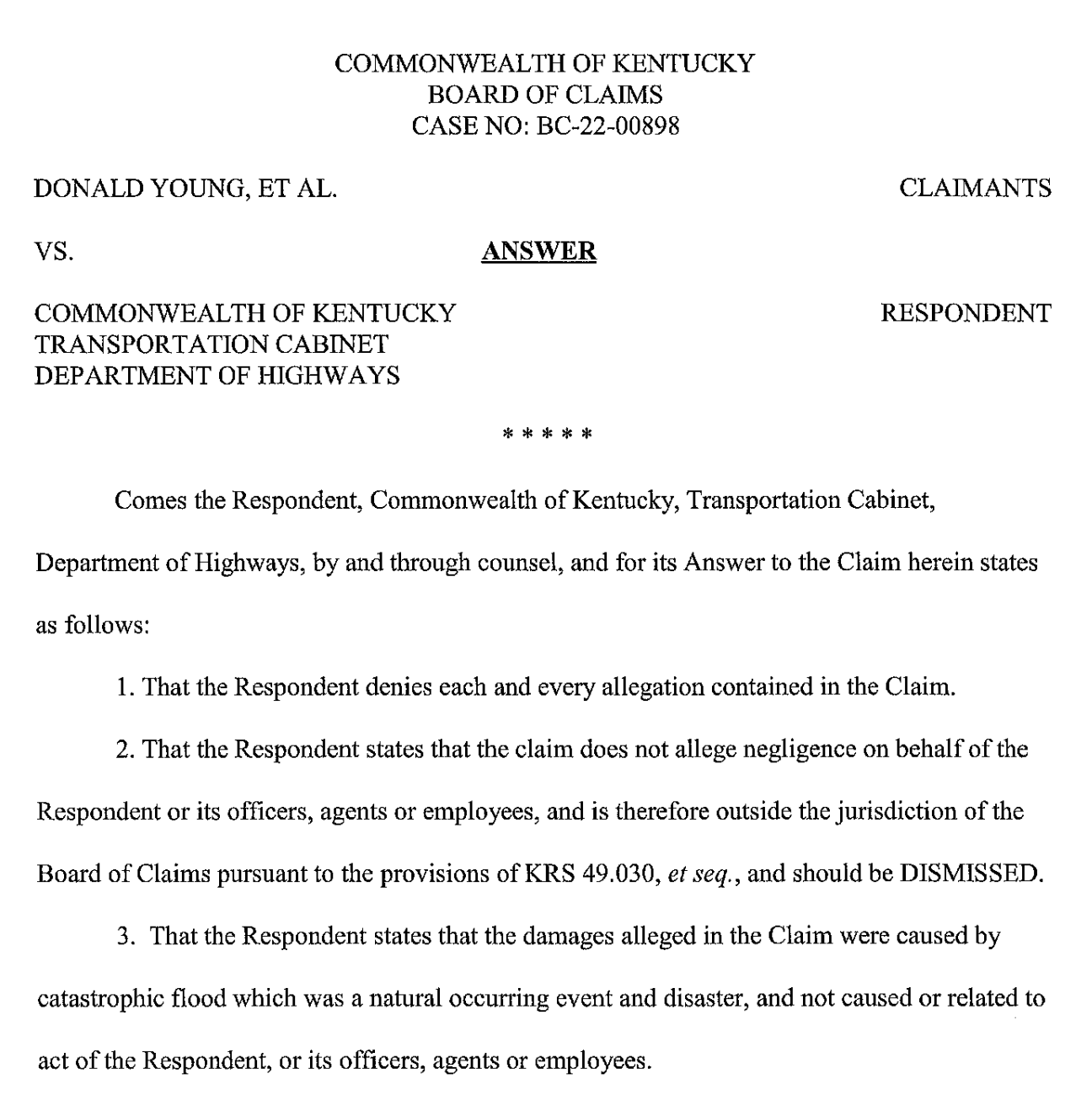 any liability in a response to the Youngs’ claim. An attorney for the Kentucky Transportation Cabinet argued the couple’s house was taken by an unnamed third party. In fact, the response said the Youngs “may themselves have been negligent in failing to remove or secure their personal property.”
any liability in a response to the Youngs’ claim. An attorney for the Kentucky Transportation Cabinet argued the couple’s house was taken by an unnamed third party. In fact, the response said the Youngs “may themselves have been negligent in failing to remove or secure their personal property.”
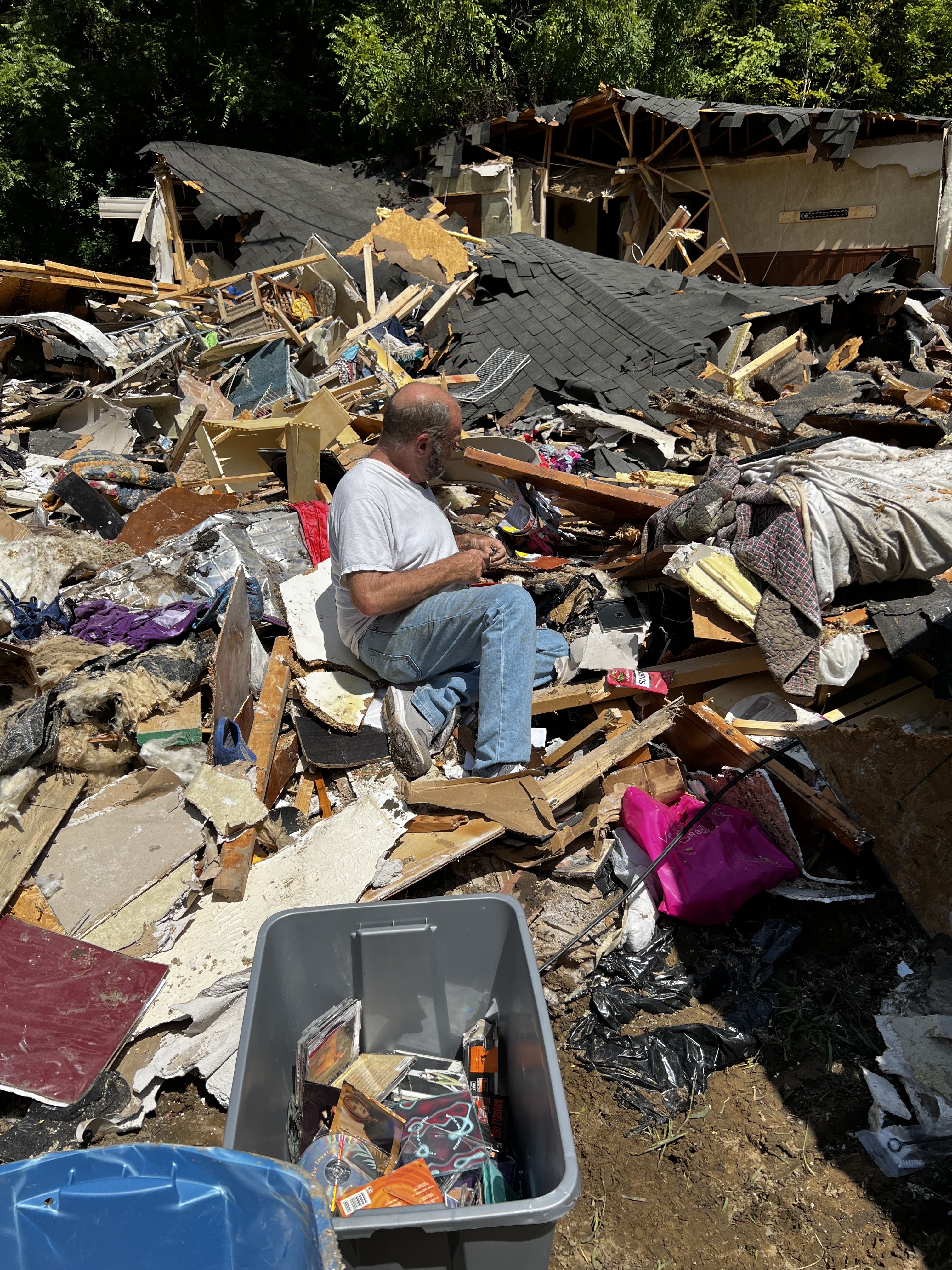
Don Young said he couldn’t do any heavy lifting to remove their belongings because of an old back injury. Plus, the couple said their vehicles were destroyed and they had nowhere to put their property after the flood.
It was all they could do to survive, they said, and make periodic trips to check on the property before the unannounced demolition.
The Youngs said cleanup workers claimed to have knocked on the door before tearing down the house. No one answered, and workers made no other attempts to call or locate the property owners. John Moore, a project manager with the Transportation Cabinet, said crews were advised to make contact with residents before starting work on their property, but that was not always possible due to the urgency of the task.
The Board of Claims is yet to decide on the Youngs case.
An investigation by the Kentucky Center for Investigative Reporting found that the Youngs’ story was an early failure among many in the state and federal government’s attempt to clean up debris and dangerous materials left by the flood.
In daily reports, advisors from the U.S. Army Corps of Engineers regularly expressed concerns about crews taking trees or other materials that did not fit federal criteria for debris removal after a disaster. KyCIR heard from residents on multiple occasions that contractors removed debris such as valuable trees from private property without permission or cut half-mile long access routes through forests. It left them feeling overtaken and ignored by the very people charged with helping them.
Meanwhile, interviews with residents of eastern Kentucky, as well as progress reports and data from the Transportation Cabinet show that there’s still plenty of debris left in eastern Kentucky even though the state officially ended the cleanup mission in December.
People living in the area contacted state and county leadership and even organized a work stoppage to sound alarms about the danger posed by lingering debris. But state officials said the cleanup process was held back by federal agencies negotiating jurisdiction over removing debris from streams.
More cleanup projects are underway to address those concerns, but time is not on eastern Kentucky’s side. When heavy rains descended on the region again in February, leftover debris clogged drains and exacerbated flooding. The way some locals see it, the debris removal process that was supposed to help them recover instead made them more vulnerable.
A Looming Danger
Between July 26 and 30, 2022, a historic round of thunderstorms came through southeastern Kentucky, dropping more than a foot of rain. Streams turned into creeks, creeks into rivers, rivers into destructive torrents.
When all was said and done, the flood caused damage across more than a dozen rural Appalachian counties and killed 45 people.
According to the National Weather Service, over 600 helicopter rescues were needed to evacuate people trapped by quickly rising floodwaters. The Foundation for Appalachian Kentucky reported 1,722 homes were totally destroyed and 3,986 homes were partial losses.
Early estimates from the U.S. Army Corps of Engineers said the July floods created nearly two million cubic yards of debris in the waterways alone. That’s enough to fill the Churchill Downs racetrack and infield 23-feet high, according to a KyCIR analysis.
Debris included vehicles, campers, doublewide trailers, uprooted trees and storage buildings, according to an early Corps assessment report.
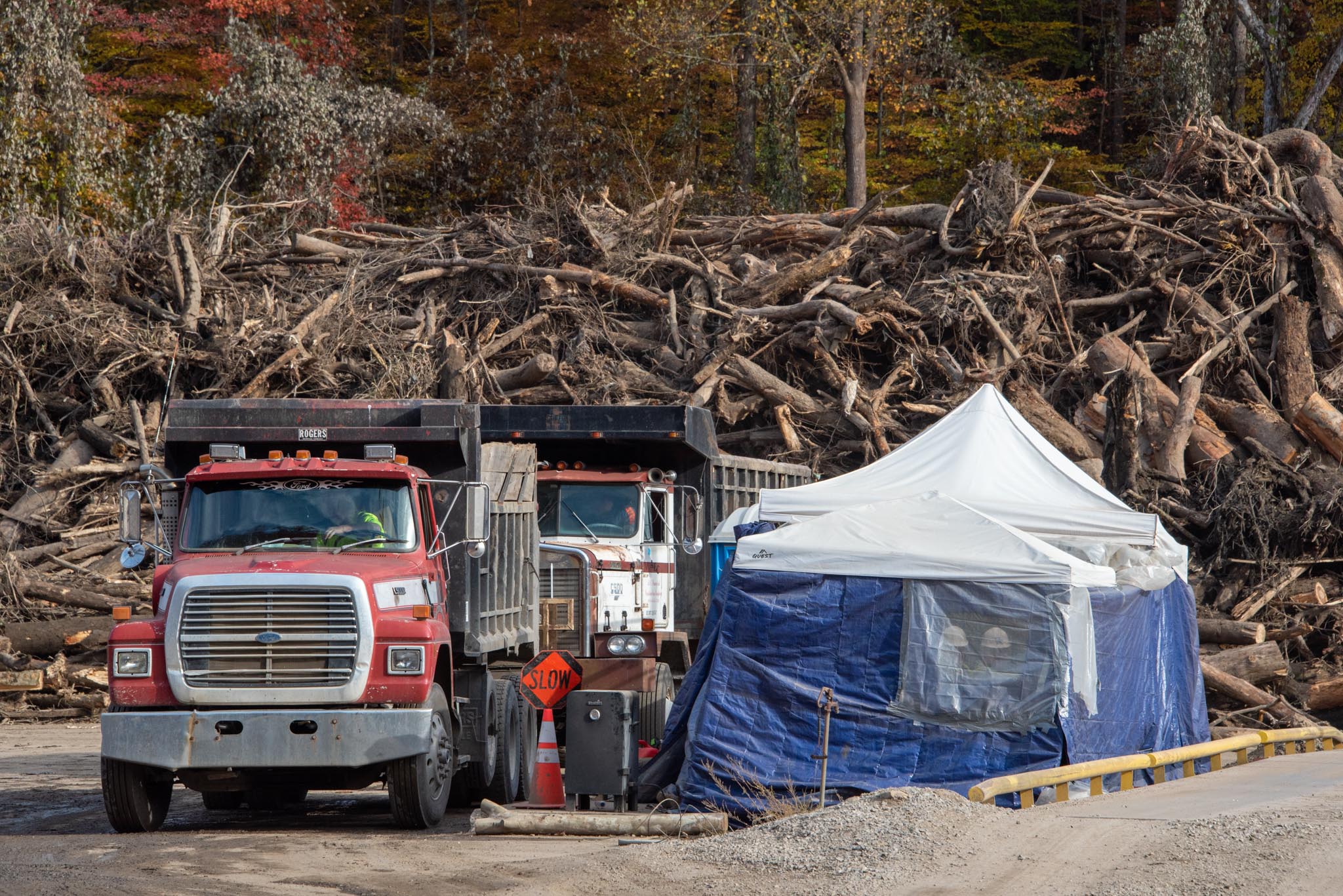
Experts say this debris poses a threat unique to mountainous eastern Kentucky. Whatever is left in the streams that scour the valleys will eventually clog the flow of water. Water with no place else to go will end up over the banks and flood nearby property.
Blockages were already starting to form according to a Corps report from August.
"The affected streams are beginning to reroute themselves," the report stated. "If more precipitation causes these streams to top their banks, these debris jams will result in even more county wide flooding."
Justin Branham was one of the Corps staffers who wrote those estimate reports. He grew up in Letcher County, less than half a mile from the Youngs home. He said the same creek that flooded the Youngs’ property ruined his parents’ garage, destroying vehicles, tools and other valuables.
Most of eastern Kentucky was in danger of flooding again because of debris piles blocking waterways, according to Branham.
“You're living in a valley that's 100 yards wide, and you've got a house, a creek, a road and a railroad,” Branham said. “And you're going to cause flooding to it if you don't get that stuff out.”
All that debris needed to get cleaned up, and quickly. Procurement documents show that, within a week after the flood, the Kentucky Transportation Cabinet signed a contract with Florida-based Ashbritt Inc. to lead the cleanup process. Since August 2022, the state has paid the company $157 million according to procurement records.
Ashbritt Founder and Chairman Randal Perkins and other executives did not respond to a detailed list of findings and requests for interviews.
While announcing the contract on Aug. 4, Democratic Gov. Andy Beshear said debris would be removed “at a rapid pace.” But more than eight months after the mission began, material still clogs streams and litters hollers across eastern Kentucky.
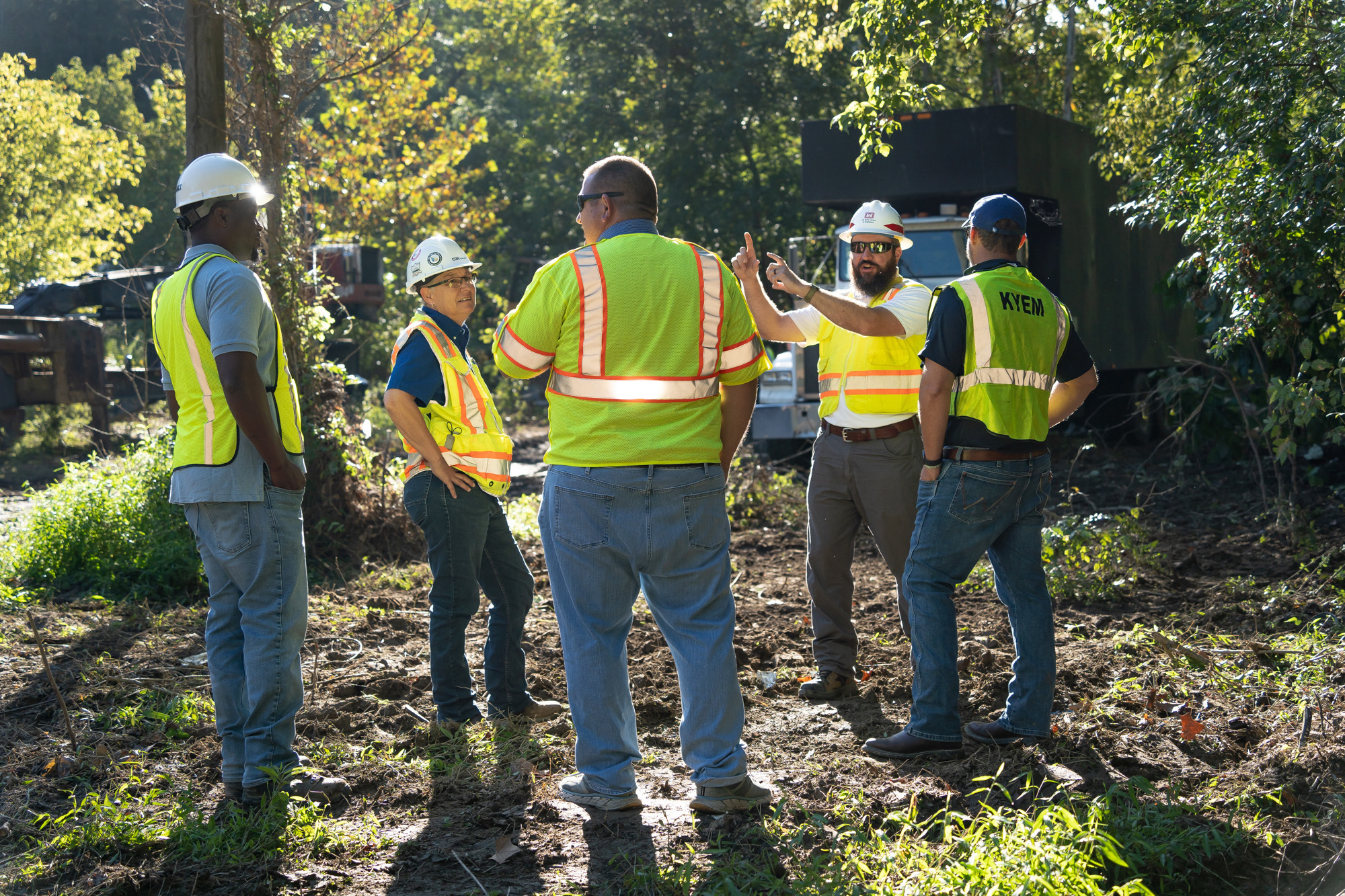
"Too Many Coaches, Not Enough Players"
From the beginning, the debris removal process hit snags. And it was dangerous.
In an email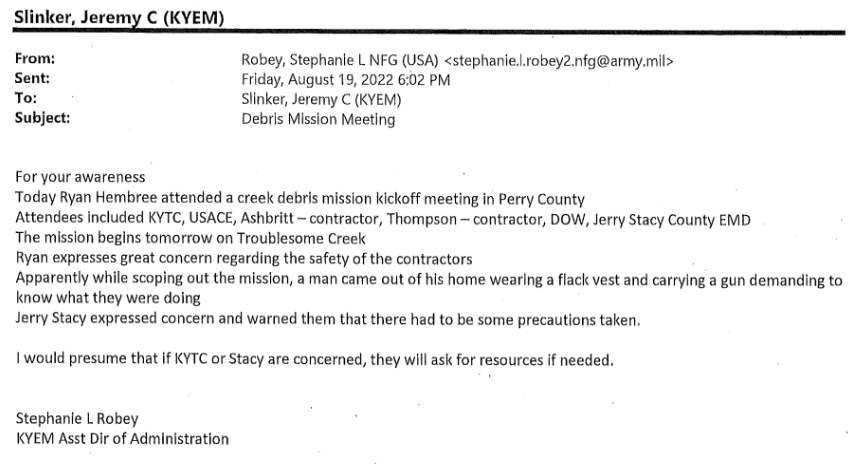 obtained through an open records request, Kentucky Division of Emergency Management officials said that when workers were scoping out debris on Aug. 19, a man came out of his house with a gun and flak jacket “demanding to know what they were doing.”
obtained through an open records request, Kentucky Division of Emergency Management officials said that when workers were scoping out debris on Aug. 19, a man came out of his house with a gun and flak jacket “demanding to know what they were doing.”
The encounter prompted one emergency manager consultant to express “great concern regarding the safety of the contractors,” according to the email addressed to Jeremy Slinker, director of the Kentucky Division of Emergency Management. Perry County Emergency Management Director Jerry Stacy warned crews that “there had to be some precautions taken.”
In a daily report compiled by several staffers, an Army Corps of Engineers advisor wrote that even trying to get an accurate assessment of the amount of debris was hindered by “too many coaches, not enough players.”
“The efficacy and efficiency of the mission is suffering from miscommunication and lack of coordination,” another Corps report
George Minges, chief of emergency operations for the Corps’ Louisville district, said the agency did an “adequate” job supporting the state and FEMA during the cleanup process.
“I think we had outstanding communication with those partners,” he said.
But local officials still didn’t have an accurate picture of where debris was located and which areas were hardest hit, according to the report. Scouting crews would show up at a site only to find no debris. Other crews would bounce from one county to another before finishing the job.
A Corps report from a few days later shows small cleanup contractors were zooming around the counties, picking up debris from roads and waterways with little to no coordination or supervision.
The Federal Emergency Management Agency will reimburse local governments for debris removal when that debris threatens health, safety or property. To make sure cleanup is done by the book, FEMA requires governments to hire monitors who watch over cleanup crews.
In reports, the Corps expressed concerns over the supervision provided by Thompson Monitoring, the company hired by Kentucky to serve this role. Corps advisors found monitors resting in their cars or positioned where they couldn’t actually see the work.
over the supervision provided by Thompson Monitoring, the company hired by Kentucky to serve this role. Corps advisors found monitors resting in their cars or positioned where they couldn’t actually see the work.
When emailed for comment on the debris removal mission, Thompson Monitoring declined to be interviewed and instead forwarded the request to the Kentucky Transportation Cabinet.
According to interviews with state officials and people involved in the cleanup process, the Transportation Cabinet decided to organize the project into two distinct sections: One mission focused on roads, another focused on clearing out the waterways.
The waterway mission would prove the most difficult part of the cleanup process, in part because creeks often run through private property. This created tension between cleanup workers and the residents of eastern Kentucky who were already going through a terrible ordeal.
People like Laverne Fields said they watched as crews cleaned up some debris, but left other material behind, seemingly without any explanation.
The flood left Fields’ house straddling a creek in Letcher County with bags of debris piled out front. She said debris contractors wouldn’t touch the bags of garbage. Instead they tore the house down before she could recover a safe containing vital documents she would need to get help from FEMA down the road.
“They ripped our bedroom off, that’s where [the] safe was at,” Fields said. Fields said she was never able to find the safe.
“I don’t know who they worked for,” Fields said. “They didn’t even ask me…They yelled at me over it.”
They didn’t have to ask.
Contractors and monitors interpret FEMA’s debris removal policies to determine what is debris and whether it needs to be removed, without input from property owners.
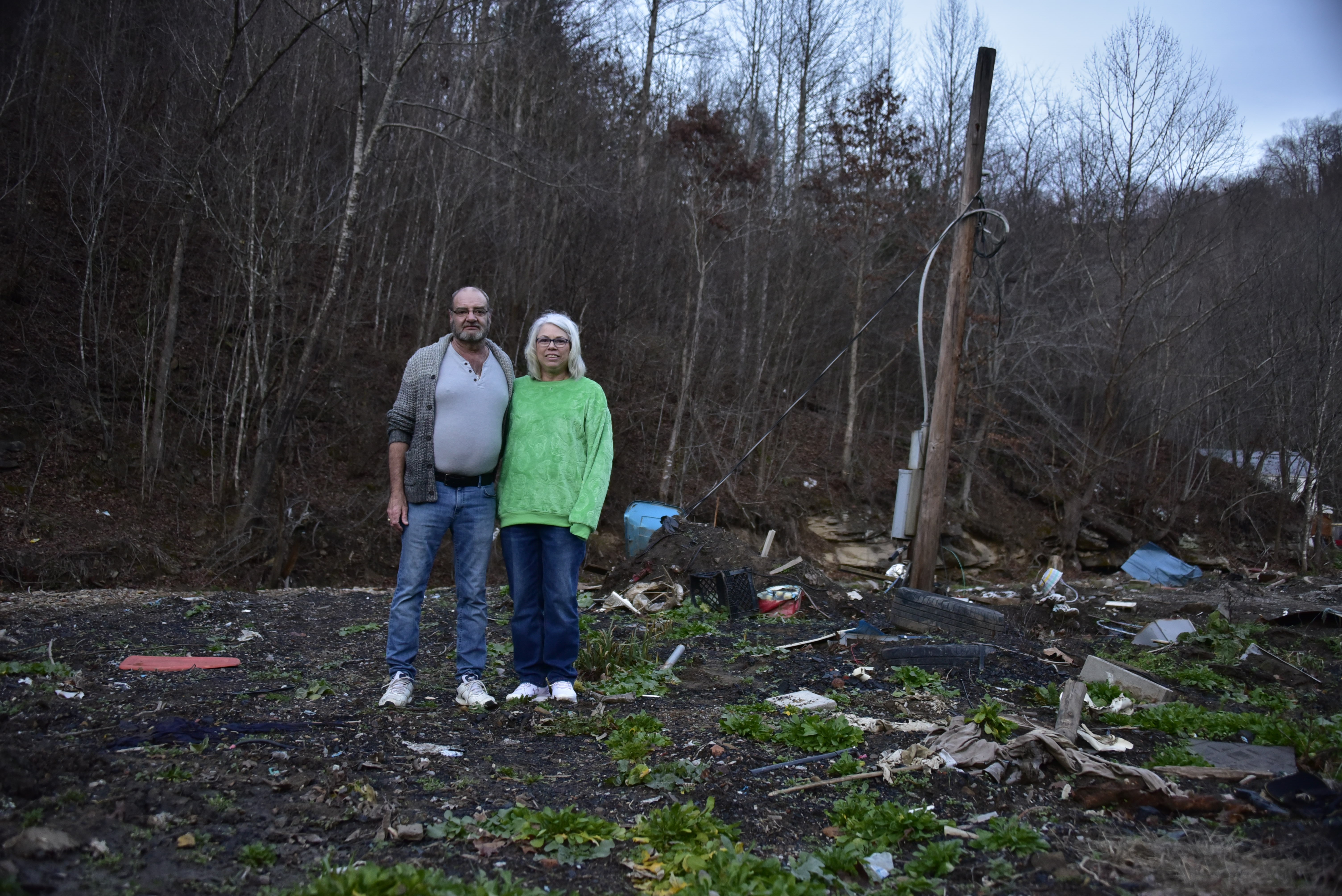
"You Picked The Wrong House"
Don and Malissa Young said they spent the night of the flood watching the torrential downpour and worrying.
A neighbor’s house crashed into theirs. They jumped into the rushing water, which pulled them down the flooded street. Don, who can’t swim, said he survived by holding onto a neighbor's porch. Malissa said she clung to a tree branch with their two small dogs tucked under her arm until the water receded enough for a rescue.
Their doublewide trailer was lifted off the foundation. Don Young said he knew it was waterlogged, but many of their belongings inside were still salvageable.
The Youngs took refuge with a relative in Virginia, just across the state border with Kentucky.
They returned every few days to check on their property when they could borrow a vehicle, since theirs were destroyed. The Youngs said that, over the next few weeks, they salvaged what they could in plastic bins until they could return with a larger vehicle and someone to help move heavy items.
The work was slow and emotionally grueling.
Then on Aug. 22, the Youngs said they got an alarming call from their neighbor: A cleanup crew was tearing down the house. If they wanted to save anything left behind, they needed to get there quickly.
They raced back to McRoberts to find their house half demolished, the scoop of an excavator poised above the rest as the workers took a break for dinner.
Don Young confronted the cleanup workers. He wanted to know who authorized the crew to take his home without so much as a warning. Young said a field supervisor from Thompson Monitoring Services introduced herself and told him to take his complaints up with Gov. Andy Beshear.
“She said the governor told them to tear down anything that they thought was in danger of causing a flood if it rained,” Don said. “I said, ‘Well, you picked the wrong house.’”
The Corps report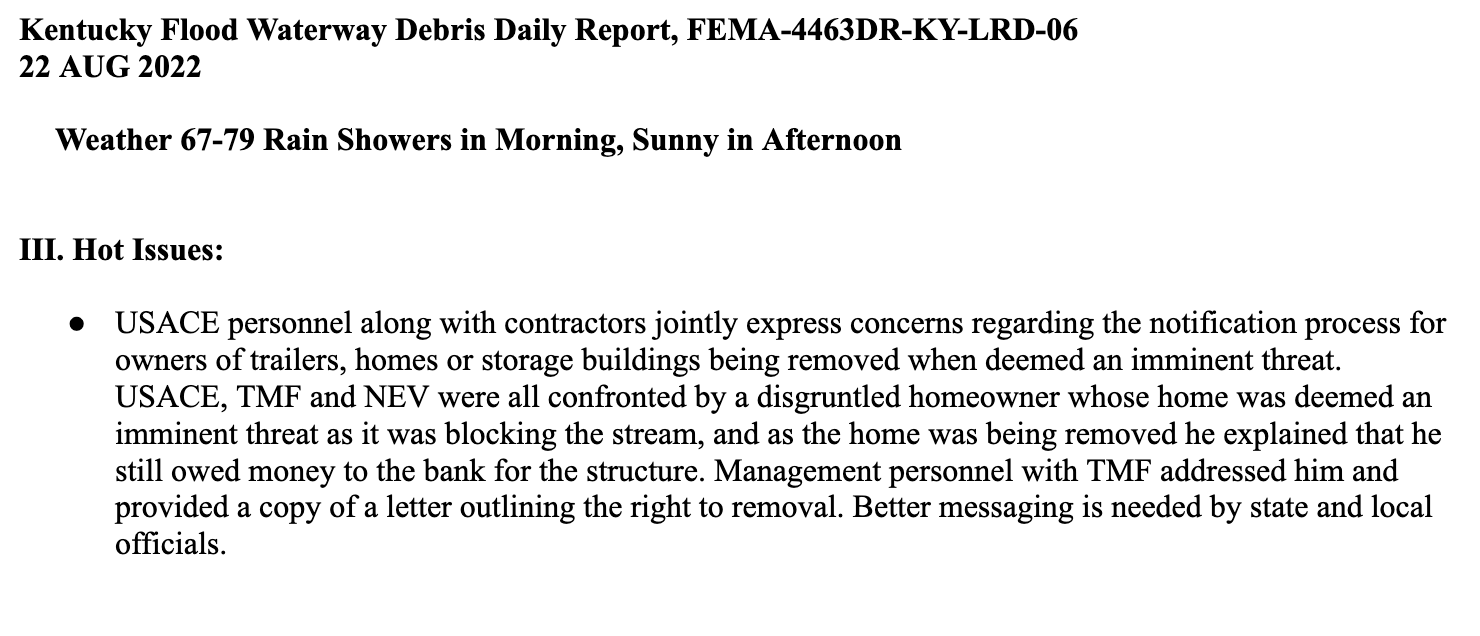 about the incident said everyone on the site that day had concerns “regarding the notification process for owners of trailers, homes, or storage buildings being removed.” It ended with a plea: “Better messaging is needed by state and local officials.”
about the incident said everyone on the site that day had concerns “regarding the notification process for owners of trailers, homes, or storage buildings being removed.” It ended with a plea: “Better messaging is needed by state and local officials.”
Justin Branham was the Corps staffer who wrote that report and knows the Youngs personally. He said when things went wrong during the cleanup process, contractors would point the finger at him and the Corps. Since he was from the area, Branham became the face of the project to many of his neighbors. It didn’t sit well with him.
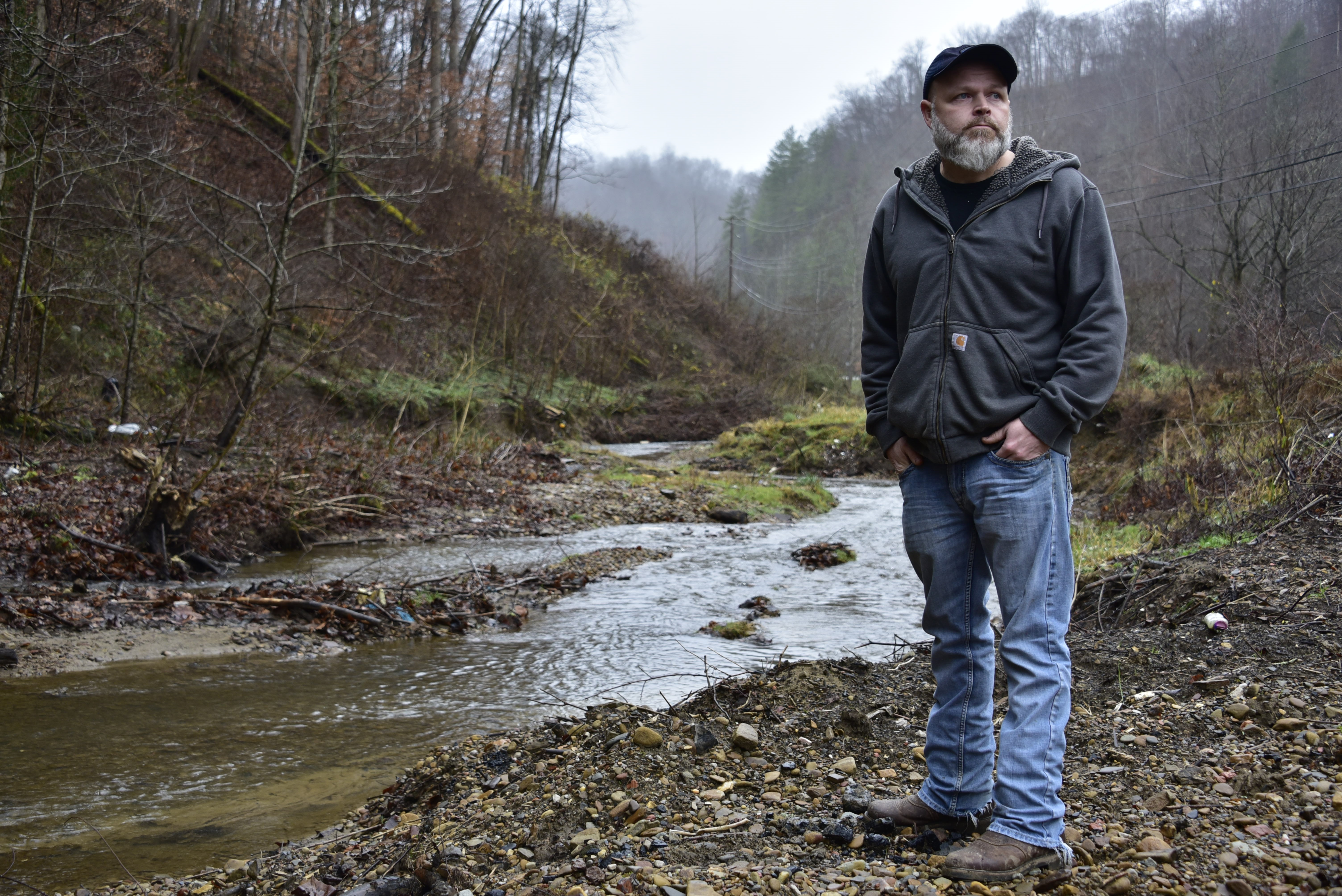
“You're pitting people against people they don't need to be pitted against, they should be working as a team,” Branham said. “And I should be able to go out into my community and say I'm doing the best I can to help these people.”
Later that week, Don Young called Beshear’s office, upset and wanting to talk “man to man,” according to an email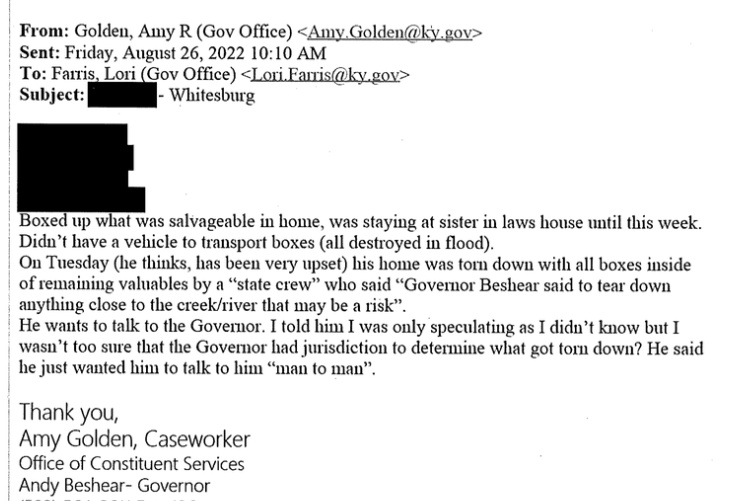 from the governor’s office summarizing the call. Don said a constituent services representative said he couldn’t speak with the governor, but that they would pass his concerns along to the appropriate agency.
from the governor’s office summarizing the call. Don said a constituent services representative said he couldn’t speak with the governor, but that they would pass his concerns along to the appropriate agency.
Emails show the governor’s staff reached out to the Transportation Cabinet and emergency management team for an explanation.
Jim Garrett, head of volunteer programs for Kentucky Emergency Management, wrote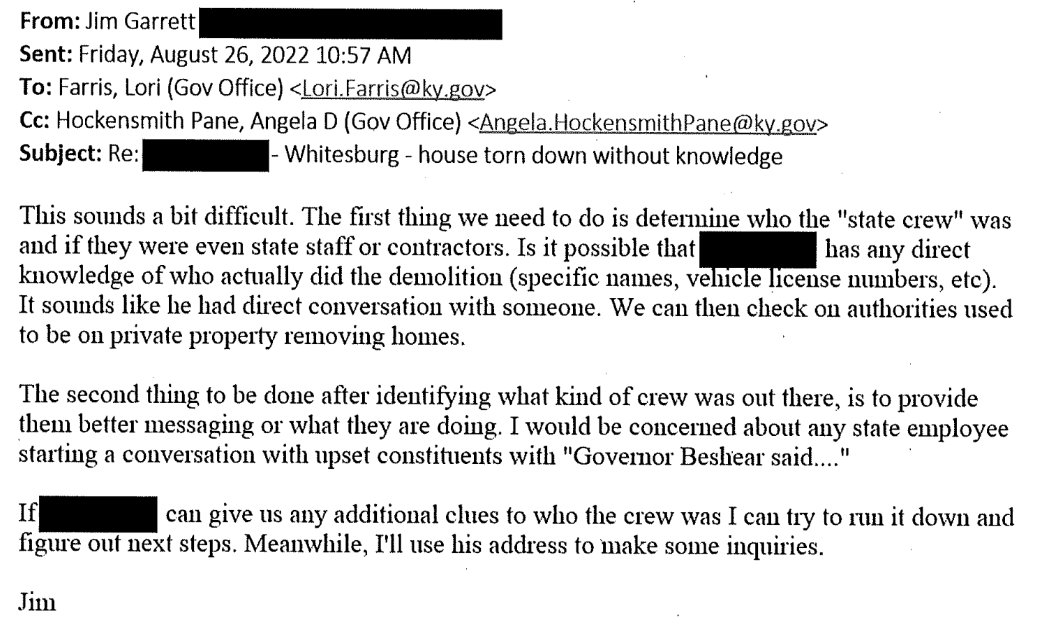 back that work crews needed to be given “better messaging on what they are doing.” Garrett said he was concerned about “any state employee starting a conversation with upset constituents with ‘Governor Beshear said…’”
back that work crews needed to be given “better messaging on what they are doing.” Garrett said he was concerned about “any state employee starting a conversation with upset constituents with ‘Governor Beshear said…’”
John Moore, with the Transportation Cabinet, responded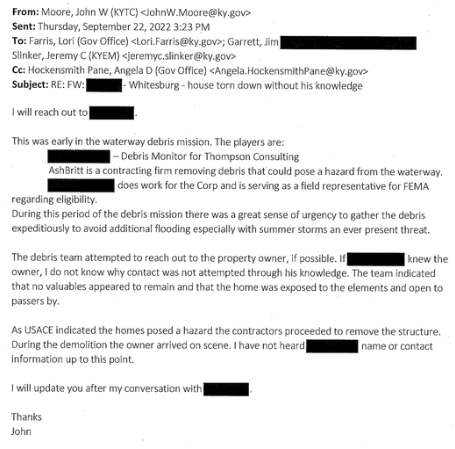 to the governor’s team, saying that at this point in the cleanup process, “there was a great sense of urgency to gather the debris expeditiously to avoid additional flooding.” Moore said he would reach out to the Youngs directly.
to the governor’s team, saying that at this point in the cleanup process, “there was a great sense of urgency to gather the debris expeditiously to avoid additional flooding.” Moore said he would reach out to the Youngs directly.
Moore called Don Young, who explained the situation as he saw it: The home was not in danger of falling into the creek and causing additional flooding, Don said, and he sent pictures showing the exact location of the house.
After the conversation ended, Moore emailed the Youngs instructions on how to file a negligence claim with the state Board of Claims. After the Youngs filed their claim in November, the Transportation Cabinet responded that the couple’s home was demolished by an unnamed third party. The Kentucky Board of Claims is yet to decide on the Youngs negligence claim, pending a hearing that has not yet been scheduled. The Youngs now have a lawyer and are exploring other avenues for legal action.
Cleanup crews were paid by the ton for debris removed.
Don Young alleged that fact explains why crews were in such a hurry to demolish his house.
“Somebody saw a dollar sign there and just tore it down, I think,” he said.
Just two days after crews demolished the Youngs’ home, the state bestowed anyone working on debris cleanup with the legal right to enter private property through a memorandum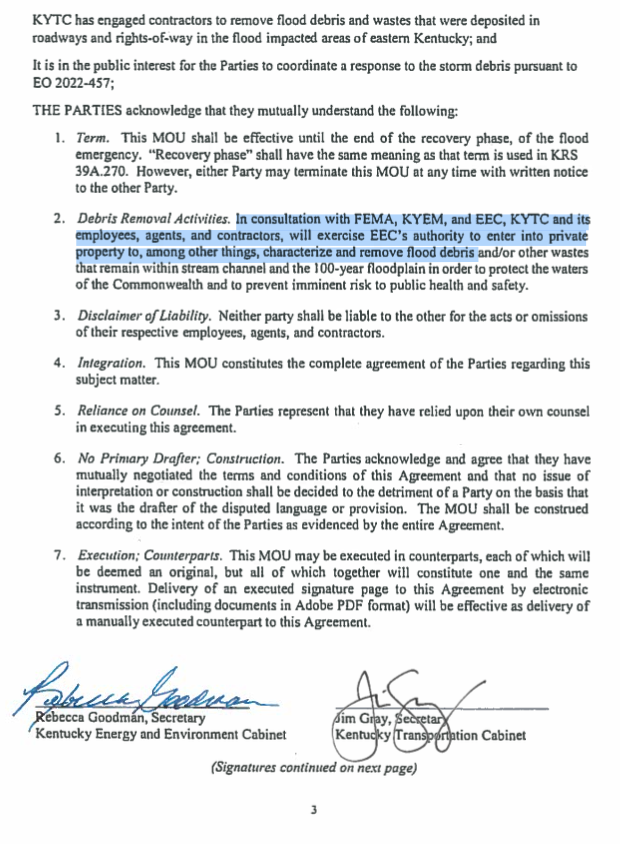 of understanding between the Kentucky Energy and Environment Cabinet and the Transportation Cabinet. The environment cabinet has the authority to enter private property in emergencies that threaten public health. The cabinet extended that authority to crews clearing flood debris through this memorandum of understanding.
of understanding between the Kentucky Energy and Environment Cabinet and the Transportation Cabinet. The environment cabinet has the authority to enter private property in emergencies that threaten public health. The cabinet extended that authority to crews clearing flood debris through this memorandum of understanding.
“The debris can not only impede stream flow but also may threaten the release of hazardous substances,” the memorandum of understanding explained.
To clean up debris, the Transportation Cabinet and its contractors were allowed to “enter into private property to, among other things, characterize and remove flood debris.”
Kentucky environmental attorney Randy Strobo said Kentucky law seems to justify that authority. But he said that power should be used carefully and communicated clearly.
“I think that needs to be limited. It's not like you can do whatever you want,” Strobo said.
John Moore, with the Transportation Cabinet, said in an interview that cleanup crews were instructed to make attempts to contact property owners before starting the work.
“We advised them to work ahead to the greatest extent possible to knock on doors…but due to the urgency of the waterway, [we needed] to clear out the bridges and waterways to prevent additional flooding,” Moore said. “That was not always possible. The urgency of the mission was paramount.”
Even before the incident with the Youngs, Corps reports suggested that “law enforcement be available” if homeowners attempted to prevent the removal of structures.
that “law enforcement be available” if homeowners attempted to prevent the removal of structures.
Nearly a month later, the same work crew that demolished the Young's home was confronted with threats and resistance when they tried to cut down live trees they considered to be a hazard to future flooding. This time they tried the law enforcement approach. A young, untrained police officer arrived on the scene to tase and arrest the homeowner.
The homeowners had no prior notice or information about what was happening and the mission debris workers were on. Like the Youngs, they’re also investigating legal remedies.

“Those Hanging On By A Thread Will Be Left With Nothing”
Despite this broad authority to enter private property, many eastern Kentucky residents began to feel the cleanup crews were not being sufficiently thorough. Records show nearly 300 calls to a debris hotline managed by the Transportation Cabinet. Some residents called multiple times over the course of months.
A series of complaints from the Calhoun family in Knott County show four calls from October to January complaining about debris blocking the creek near their home. During a call on Jan. 3 Victor Calhoun reported that the creek was still blocked with trees, garbage and siding.
from the Calhoun family in Knott County show four calls from October to January complaining about debris blocking the creek near their home. During a call on Jan. 3 Victor Calhoun reported that the creek was still blocked with trees, garbage and siding.
On Nov. 18, a Letcher County resident who lives near Rockhouse Creek told a hotline operator that FEMA “has cleaned the creek but it has been done incorrectly.” Two weeks later, he called again to report that FEMA’s work had changed the path of the creek and it was “eating out 4-5 feet sections at a time of his land.”
to report that FEMA’s work had changed the path of the creek and it was “eating out 4-5 feet sections at a time of his land.”
Communication between various work crews and government agencies removing debris from waterways deteriorated as the mission dragged on.
That’s largely because another federal agency had stepped into the complex mix: the National Resources Conservation Service, a subdivision from the United States Department of Agriculture.
FEMA and NRCS both allow crews to pick up stream-clogging debris, but they follow different timelines. FEMA's work starts immediately while the NRCS is more focused on long-term stabilization. There’s some overlap in those tasks, and FEMA guidelines stipulate that the agency won’t pay for any work the NRCS takes on, even if the NRCS doesn’t have the funding needed at the time. Moore with the Transportation Cabinet said that created an “impasse” that held up progress.
“At the very early stage in order for FEMA to get moving, they had to draw a line in the sand,” Moore said.
Many of the debris workers weren’t privy to that line in the sand. They were constantly told by monitors to leave behind massive piles of debris. Not only did it mean they were passing up a chance to make more money, they felt like they were leaving dangerous garbage in communities they were supposed to be helping.
“They were changing guidelines every single day,” said John Collins, a local business owner who worked as a subcontracted debris hauler under Ashbritt, the company hired by Kentucky to manage the debris project. “They wouldn't let us get any sediment. They wouldn't let us get anything out of the creek. All you could get was a few dead trees and some garbage.”
Others noticed the problem including Corps staffer Branham, who wrote a scathing email to state officials in late September. Branham was writing as a concerned citizen, and in interviews with KyCIR has been clear he does not speak on behalf of the Corps.
“The amount of sediment still sitting in these choked channels is incredible and the mission mostly funded by FEMA to remove it is being squandered and ran amuck,” Branham wrote. “There are people hanging on by a thin thread up here and if another decent rain hits, those hanging on by a thread will be left with nothing.”
Some work crews even went on a temporary strike in October, unhappy with how they were being directed to leave behind areas of waterways full of debris. Neither the strike nor Branham’s warnings resulted in meaningful changes.
Unlike FEMA, the NRCS needs to apply for funding on a project-by-project basis. This means much of the stream work left to do in eastern Kentucky will need to wait until the agency secures funding and lines up agreements with local governments.
NRCS engineers and public information officers will not release information about when and where their work in eastern Kentucky will take place. However, KyCIR found data on an online map last updated in September 2022, showing nearly 450 locations in eastern Kentucky marked as “Approved NRCS Sites.” NRCS employees confirmed this data was accurate at that time, but has now changed.
Also in October, Gov. Beshear made an appearance at the University of Kentucky’s Blue and White basketball game, a pre-season scrimmage in Pikeville. Beshear said in a pre-game interview that workers were making great progress towards removing debris from eastern Kentucky.
“We are close, which is amazing three months out, to take that chaos and ship it out of town, out of county and out of state,” Beshear said.
But records show there was still plenty of work left to do.
In late November, the U.S. Army Corps of Engineers wrote a memo to state officials estimating the scope of work left to do. In Letcher County, they expected another six to eight weeks.
But Ashbritt told crews to wrap up work by Dec. 22, just five weeks later.
Calvin Waddles, a district magistrate in Knott County, reached out to the Transportation Cabinet in early August to complain about a complete blockage of the Beaver Creek near the border with Floyd County, according to a daily report from the Corps. He asked that the blockage be given priority status because rain could cause “a second round of flooding in the area.”
Waddles said the Beaver Creek blockage was still not cleared as of March 6.
“They still need to come back, this needs to be cleaned up,” Waddles said in a phone call. “There's debris, basically, from mountainside to mountainside.”
An analysis from Kentucky Center for Investigative Reporting found that as of Dec. 22, only 59% of the debris initially estimated by the U.S. Army Corps of Engineers to be on ground following the flood had been picked up.
State officials said those estimates included categories of debris that FEMA wouldn’t pay to clean up, and as such were not the focus of the initial cleanup project.
When presented with KyCIR’s findings multiple times, a legislative representative for FEMA said “state and locals are responsible for debris removal” and that they are “supposed to have contracts in place” before a disaster. Kentucky did not. The representative was unsure if it would affect FEMA’s reimbursement. Despite promising more information, they never contacted us again.
Regardless of who pays, debris left behind is more than an eyesore. It can make future flooding worse.
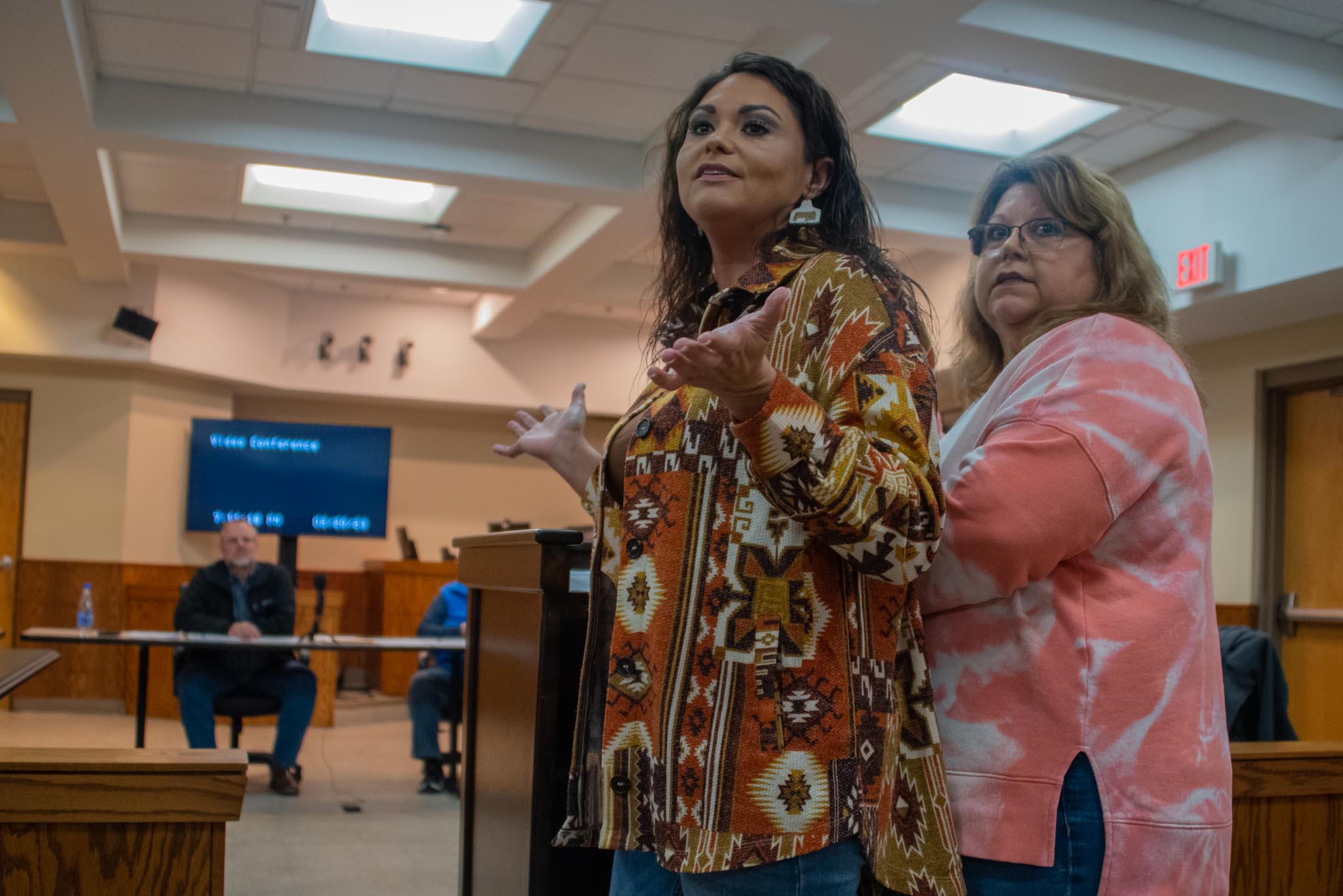
"Band-Aids On Bullet Wounds"
Nearly seven months after what survivors have labeled the “big July flood” Tonya Boggs walked up to the podium at a monthly meeting of county officials. She was visibly frustrated. Her mother, Teresa Burke, stood beside her for support.
“It’s hard when you’re trying to rebuild what was destroyed, and then here this happens, and the water came right back in my house,” Boggs told county officials, politely trying to contain her anger.
The weekend before, a heavy rainstorm prompted the governor to declare another state of emergency for 22 counties due to flooding and landslides. Nearly a dozen of those counties were still trying to recover from July’s floods.
Boggs and Burke told officials that, even before the rain, debris clogged brand new culverts that were installed by cleanup crews. Then during the February storm, an embankment upstream gave way and washed down the creek, further clogging the culverts until they dislodged. That
led to another flood in the house she’s frantically been trying to restore since July.
“Those culverts are halfway…and some of them are more than halfway full of just pure mud and sand and dirt and rocks,” Boggs said.
Many county officials were upset, too. Letcher County Judge Executive Terry Adams said he knows the culverts are “inadequate.” But he said that’s the only thing FEMA or the state will pay for. He said the temporary work often isn’t appropriate for the stream.
”The state and FEMA would not do that,” Adams said. “They wouldn’t put a bridge back in [where one had been before].”
Some of the local contractors who worked on the waterways were at the meeting too. They said they predicted this would happen long before Boggs’ house flooded again. Their warnings went unheeded, however, and they were constantly told to leave debris behind without much of an explanation.
“Every time we get a lot of rain this is what’s going to happen,” local debris contractor Wade Adams said. “It’s not our fault. I know everyone is mad at the contractors, but we can only do what we were told to. You can’t just clean out a part of the creek. ”
Most in eastern Kentucky say this is a familiar story. Government officials make TV appearances, but don’t listen to locals. They make promises they can’t deliver.
Candice Fields, disaster coordinator for the Kentucky River Area Development District, said the help that does come is akin to a “band aid on a bullet wound.”
"Andy Beshear gets on [the TV] and says, ‘Oh, things have changed,’” said Angela Collins, a Letcher County resident who is married to contractor John Collins. “Well, get your high horse down here and see how much it changed. Because they left garbage! Do we deserve garbage all over our land? No, we don't. We're not a bunch of you know, nutsy hillbillies. We're human beings just like everybody else."
To make things more dire, Collins said everyone knows spring is the wettest season in eastern Kentucky. Now, everyone is bracing for the worst.







